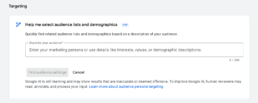Written by FiveStones – a certified Google Marketing Platform Sales partner helping global brands grow through digital strategy and ad tech.
TL;DR: Audience Targeting in DV360 (2025)
DV360 no longer works off fixed audience lists. With Similar Audiences deprecated, DV360 now uses your audience inputs as signals to guide its machine learning. First-party data and intent signals feed the system, helping it dynamically find converters. In 2025, audience strategy is about guiding the algorithm, not restricting reach.
What Has Changed About Audience Targeting in DV360?
Back in 2022, targeting in Display & Video 360 (DV360) meant selecting from a mostly fixed list of audiences. Campaigns only served ads to those users. This way of thinking is now obsolete.
More than ever, DV360 is powered by real-time data and machine learning. Instead of treating audiences as fixed groups, the current DV360 uses them as signals to guide the algorithm. These signals help identify users likely to convert, even if they’re not in your original list.
| Then (2022) | Now (2025) |
|---|---|
| Similar Audiences | Replaced by Optimized Targeting (source) |
| Audience list = target boundary | Audience list = seed input for expansion |
| Campaigns use 3P cookie lists | Campaigns use privacy-safe, real-time data |
Similar Audiences is replaced by Optimized Targeting

As of August 2023, Similar Audiences have been removed from DV360. Their replacement, Optimized Targeting, uses real-time campaign data to automatically find users likely to convert—based on your audience signals (source).
- Works only with automated bidding strategies
- Expands beyond your selected audiences
- Use the “Optimized Targeting” dimension in reporting
DV360 can go beyond your audience list to find converters

Affinity and In-Market audiences still exist, but DV360 no longer restricts delivery only to those users. With Optimized Targeting enabled, these audiences serve as starting signals. DV360 can expand beyond them to find additional high-performing users, even if they aren’t in your original list (source).
Generative AI now available in audience creation workflow

DV360 now offers generative AI tools in the audience creation process. This new feature can recommend new segment ideas or refine your targeting based on your campaign goals and existing data. While it speeds up ideation, you’ll still need to manually ensure that Google’s AI-suggested audiences are aligned with your overall targeting strategy.
How is first-party (1P) data now used as audiences in DV360?
With the advertising ecosystem moving to be privacy-centric, quality first-party data can be a durable asset in targeting. DV360 enables first-party audience building through:
- Floodlight Tags: Build remarketing lists based on user actions on your site. Custom variables (u-vars) allow for product/category-level segmentation (source).
- Google Analytics 4 (GA4): Share advanced behavioral audiences, such as high-engagement non-converters. (source)
- Customer Match: Upload hashed CRM data (e.g., email, phone) to re-engage lapsed users or exclude existing ones across Google-owned inventory (source).
These 1P audiences can act as high-quality signals for Optimized Targeting, or be used for direct targeting.
Is third-party audience targeting still available in DV360?
Yes, though it’s still unknown for how long more. DV360 still integrates with third-party data providers like BlueKai and Eyeota through the Audience Marketplace (source). However, most of these audience segments:
- Are built on third-party cookies
- Incur additional CPM fees on top of media costs (source)
- Are declining in accuracy and scale due to cookie deprecation
If you continue using 3P audiences:
- Validate them before investing
- For sustainable alternatives, consider partnering directly with publishers or platforms that offer consented, first-party audience data.
Conclusion and next steps
If you’re still building campaigns around fixed audience lists, you’re behind.
DV360’s shift to a signal-based, machine learning-driven system means marketers must:
- Provide quality inputs (1P data, keywords, segments)
- Let the system learn and expand beyond your seed audiences
- Measure success using the Optimized Targeting dimension, not just audience-level performance
The better your audience signals, the better your campaign performance.
FAQ: Audience Targeting in DV360
1. Can I still use third-party audiences in DV360?
Yes, but they rely on third-party cookies, often come with added CPM fees, and are losing scale. For better performance, prioritize first-party data or explore publisher partnerships.
2. If DV360 expands beyond my selected audience, do I lose control?
Not exactly. You still define your starting signals and can apply exclusions. DV360 just uses those inputs to go broader—especially with Optimized Targeting enabled—to improve performance.
3. Does DV360 have generative AI for audience creation?
Yes. DV360 has introduced generative AI assistance within the audience creation workflow. It can suggest audience ideas, refine targeting parameters, and generate relevant segments based on prompts or campaign objectives. Learn more about this new feature here.
